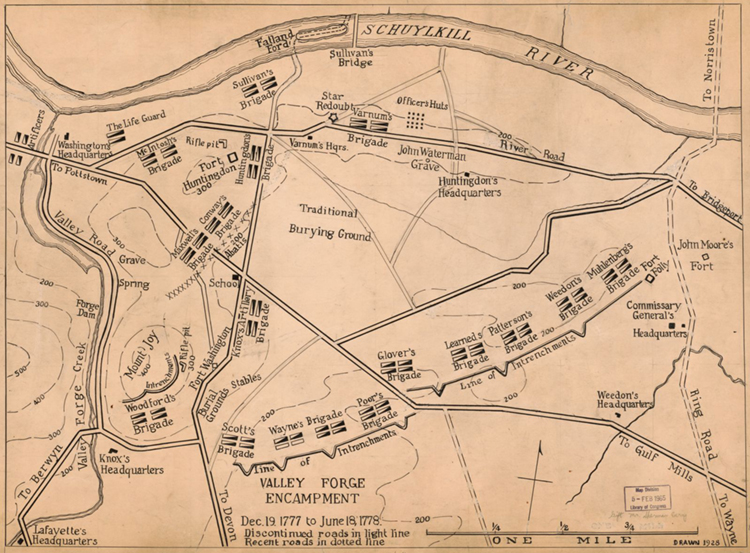Two hundred and forty years ago today, on Dec. 19, 1777, American troops of the Continental Army set up camp at Valley Forge,Pennsylvania. The camp spanned an area between Valley Forge Creek and the Schuylkill River, about 25 miles (40 kilometers) northwest of Philadelphia. General George Washington and his troops stayed at Valley Forge until June 1778, during the American Revolution (1775-1783). The winter months were difficult for the Americans, who suffered from cold, hunger, and disease.
Washington led his troops to Valley Forge after discouraging defeats at nearby Brandywine and Germantown. These losses left Philadelphia, at that time the American capital, under British control. Washington’s soldiers had little food and too little clothing to protect themselves from the cold. The Continental Congress could not provide more supplies for them. The army of about 10,000 lived in crude log huts that they built themselves. On Dec. 23, 1777, Washington wrote: “We have this day no less than 2,873 men in camp unfit for duty because they are barefooted and otherwise naked.” An estimated 2,500 soldiers died at Valley Forge. Many others were either too weak or too sick to fight because of a smallpox epidemic.

The winter at Valley Forge tested the loyalty of the American troops. Only dedicated patriots stayed with the Continental Army. Many people criticized Washington, but he held his position at Valley Forge throughout the winter and spring. He improved his troops with the help of Baron von Steuben, a former Prussian soldier. Steuben drilled the soldiers in a system of field formations. By spring, Washington had a disciplined, well-trained army. The news of the alliance between France and the United States reached Valley Forge on May 6, 1778. It cheered Washington and helped him move successfully against the British in June.

Untitled Document
Can't view the linked articles? Subscribe to World Book Online

World Book Online delivers a progressive sequence of core databases supported by supplemental
tools, such as language translation, graphic organizers, and unique Webquests. Moving from
Early World of Learning to World Book Advanced, World Book Online aligns end-users with their
appropriate learning levels. Each stand-alone site provides additional features to support the
needs of users’ specific capabilities.
The World Book Difference
World Book combines cutting-edge technology with traditional editorial excellence to produce
authoritative, trustworthy, and unbiased content. The digital content is updated in real time and
carefully curated for each learning level. Accessible 24/7, the content is available on a variety of devices.
World Book Online combines 21st-century instructional techniques with timely information.
By breaking down complex topics and using easily understandable text, World Book Online helps to
build fluency and increase comprehension. Featuring single sign-on capability, these sites are paired
with highly visual content to engage even the most reluctant reader. Our collection of resources kindles
a lifelong learning experience for every user. This adherence to clarity, currency, and accuracy makes
World Book’s digital offerings an information hub for the classroom, library, and beyond.
Image 1: This house at Valley Forge National Historical Park was George Washington’s headquarters during the winter of 1777-1778. Here the general coordinated the daily operations of the Continental Army. Credit: © Delmas Lehman, Shutterstock
Image 2: This map shows the Valley Forge encampment from Dec. 19, 1777, to June 18, 1778. Washington’s headquarters, top left, is at the confluence of the Schuylkill River and Valley Forge Creek. Credit: Library of Congress
Image 3: Winter at Valley Forge, Pennsylvania, was a difficult period for the Continental Army. General George Washington, depicted here on horseback, led his discouraged troops through several months of hardships. Credit: Library of Congress